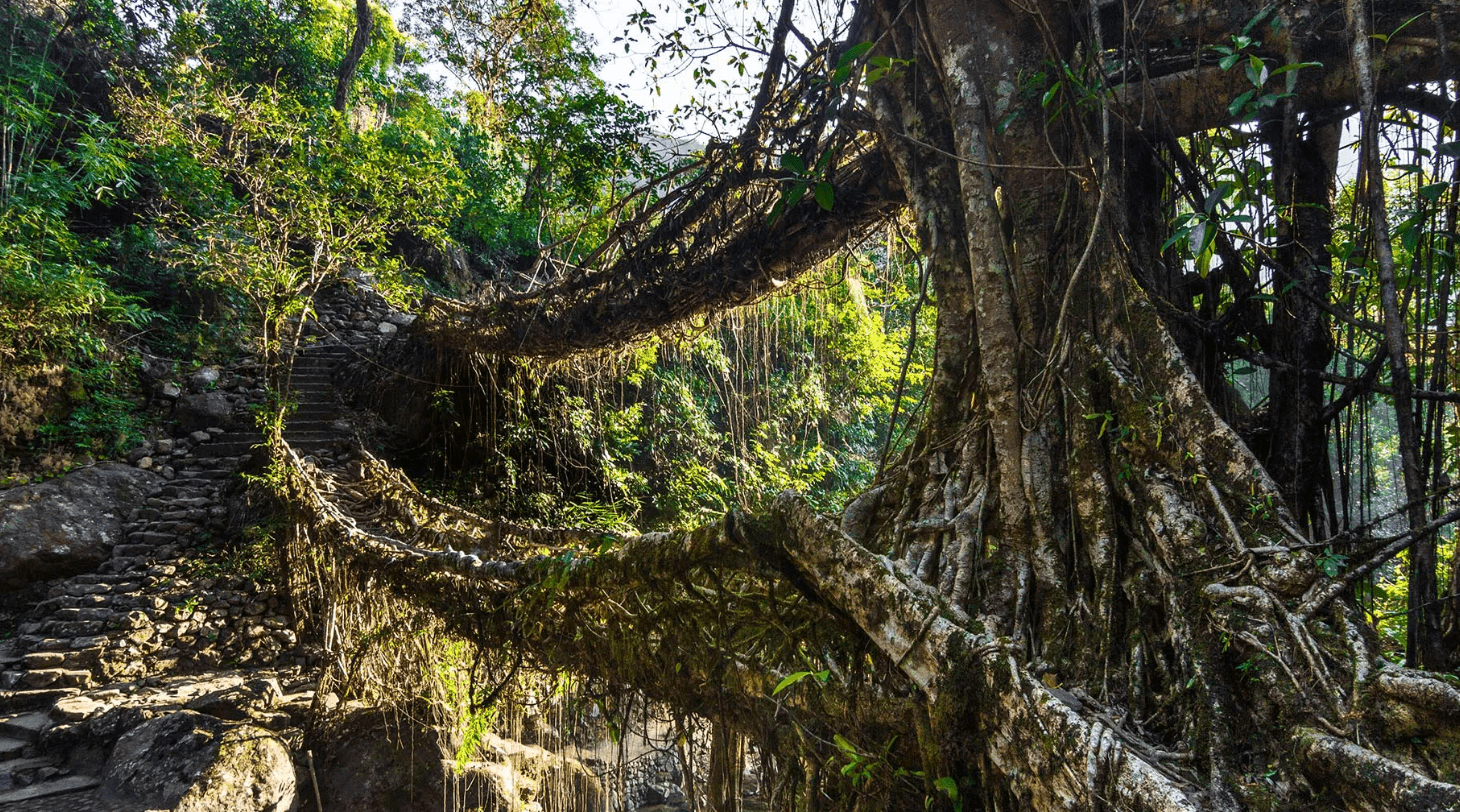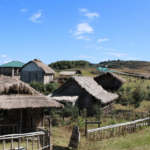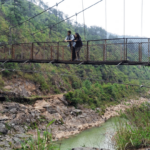Nongriat Trekking Guide: The place is truly a paradise. It takes your breath away the moment you set eyes on it. The saying that the most rewarding views follow the hardest climbs proves true with the Nongriat Trek. The trek involves descending and ascending approximately 3500 steps, leading us to the stunning Double Decker Living Root Bridge. Seeing the living root bridge for the first time was a breathtaking experience, making all the effort of the climb seem insignificant. The sheer beauty and serenity of the place made us eager to return again and again.
I’ve always been intrigued by the living root bridges of Meghalaya since I first learned about them. The concept of these bridges growing organically fascinated me. Nongriat boasts a unique double-decker root bridge, and the natural wonders of Meghalaya, including its waterfalls, sacred groves, and mountain rivers, never cease to amaze us. After the David Scott Trail, the Nongriat Trek near Cherrapunji was long awaited.
The Story of the Living Root Bridges of Meghalaya
In Meghalaya, located in northeastern India, you walk on bridges that are not built but grown. These living root bridges are a testament to nature’s harmony with human ingenuity. I first heard about these bridges during school and was curious about why they were called “living.” It turns out that these bridges represent a profound connection between nature and humanity.
The Khasi people of Meghalaya have always been closely connected to nature. This relationship is evident in every aspect of their lives. Most people in northeastern India share this intimate bond with nature. When the Khasis discovered the special properties of the roots of a particular rubber tree species, they decided to harness these properties for their benefit while preserving the environment.
Meghalaya, known as the “abode of clouds,” is characterized by heavy rainfall. The Khasi and Jaintia hills are intersected by numerous fast-flowing mountain streams that flood during the monsoon. To cross these rivers, locals initially built bamboo bridges, which were not durable. They observed that the roots of the Indian rubber tree, Ficus Elastica, would spread from the trunks and cling to rocks along the riverbanks, preventing soil erosion and anchoring the trees.
Growing Root Bridges by the Khasi People of Meghalaya
The Khasis and Jaintias utilized these roots to create bridges. They directed the growth of the roots by channeling them through hollow betel tree trunks toward the opposite riverbank. Once the roots reached the other side, they were allowed to take root. Over ten to fifteen years, the roots would strengthen and become usable. The hollow trunks provided essential nutrients for the roots.
In some cases, roots were simply pulled, tied, and twisted to intertwine over time. These living root bridges continue to grow as long as the tree remains healthy. Although the bridges take years to become fully functional, they eventually become strong enough to support up to 50 people. Many of Meghalaya’s root bridges are nearly 500 years old.
Root Bridge of Meghalaya
Nongriat Trek to the Double Decker Root Bridge
I initially thought that living root bridges were only found in Nongriat near Cherrapunji and Riwai village near Mawlynnong. However, Meghalaya has numerous root bridges scattered throughout. The most famous is the Umshiang Double Decker Root Bridge in Nongriat. This bridge is remarkable for its two levels, stacked like a double-decker.
The trek begins in the small village of Tyrna, near Cherrapunji. The journey involves climbing approximately 3500 steps to reach Nongriat village, a challenging endeavor. We had been in Cherrapunji for a few days before deciding to embark on the Nongriat Trek and continue to Rainbow Falls. Here, I’ll recount our experience of the Nongriat Trek and provide essential information about it.
Cherrapunji to Tyrna | The Beginning
We left Cherrapunji early in the morning, searching for a shared car to Tyrna. Drivers were initially reluctant to accept our shared fare but eventually, we found a taxi willing to take us to Tyrna for Rs 50 per person.
Tyrna, about 12 km from Cherrapunji, took us around 40 minutes to reach. The village is charming, with quaint houses and beautiful gardens. Near the starting point, there’s a small store, and local boys often offer their guiding services. Although the path is well-marked, a guide might be helpful if you’re unfamiliar with the trail or plan to visit Rainbow Falls. We opted not to hire a guide and set off toward Nongriat.
Tyrna to Nongriat | The Journey Towards Heaven
We were aware of the 3500 steps ahead and decided to spend the night in Nongriat to avoid completing the trek in one day. Descending was relatively easy, though the steep steps were a challenge. I attempted to count the steps but soon realized my count was inaccurate. After about 1500 steps, we reached Nongthymmai, considered the midpoint. Here, there’s another root bridge that requires a Rs 10 entry fee and Rs 20 for photography.
We visited the root bridge, a beautiful structure spanning a stream, before continuing to Nongriat. As we neared an iron suspension bridge, the view of the river below was mesmerizing. The unique hues of Meghalaya’s waters evoke a sense of calm.
Suspension Bridge on the Way to Nongriat
We encountered another suspension bridge and a set of stairs to climb, which felt more strenuous after the descent. The final stretch included a small root bridge at the village entrance, giving us a preview of what was to come. Nongriat now has several homestays, which some feel might be affecting the village’s charm.
The Double Decker Root Bridge at Nongriat
Arriving in Nongriat, both Agni and I were excited to see the Double Decker Root Bridge. We quickly made our way to the bridge area, passing through a small ticket counter. The bridge was magnificent, with the river flowing beneath it. Surprisingly, we were alone at the bridge for a while, which is unusual. Sitting by the stream, the tranquility made the fatigue vanish.
Waterfall Near the Nongriat Root Bridge
Nearby, small shops offered snacks and tea. After resting, we walked over both the lower and upper root bridges. Eager to visit Rainbow Falls, we planned to continue our trek, but a tragic incident involving a drowning at a nearby natural pool, the Blue Lagoon, led to the closure of the trail to Rainbow Falls.
Nongriat to Tyrna | The Return
We returned to Nongriat by 2:00 pm, explored the village, and decided to trek back to Tyrna that same day. The return journey was grueling, with the final ascent proving particularly challenging. We arrived at Tyrna and opted to stay at a local homestay for the night due to exhaustion and the difficulty of finding transportation back to Cherrapunji in the evening.
The Complete Nongriat Trek Guide
How to Reach Nongriat?
First, get to Cherrapunji, about 50 km from Shillong. Shared jeeps from Shillong to Cherrapunji are available. From Cherrapunji, travel to Tyrna, the trek’s starting point. Shared taxis from Cherrapunji typically cost Rs 50 per person, while hiring a private car may cost Rs 300-400.
At What Time Should You Start the Trek to Double Decker Root Bridge? How Long Does It Take to Reach Nongriat?
Although you can complete the trek in a single day, it’s advisable to stay overnight in Nongriat if you plan to visit Rainbow Falls. The trek involves around 3500 steps, with the descent and ascent taking considerable time. We started from Tyrna at 8:00 am and reached the Double Decker Root Bridge by 10:00 am.
How Far is the Rainbow Falls?
The distance from Nongriat to Rainbow Falls is approximately 3 km, taking about 2 hours to reach. The return journey takes around 1.5 hours.
Where to Stay in Nongriat Village?
The Serenity Homestay is highly recommended. There are several other homestays available in the village, including the Travellers Nest.
Are There Any Entry Fees to Double Decker Root Bridge and Rainbow Falls?
There is an entry fee of Rs 20 for the Double Decker Root Bridge, with additional charges for cameras and GoPros. There is no fee for Rainbow Falls.
Are Guides Available for the Nongriat Trek?
Guides are available from Tyrna. While a guide is not necessary for the Nongriat trek, it can be useful if you plan to visit Rainbow Falls. Walking sticks are also available for rent.
Alternative Route to Double Decker Root Bridge at Nongriat
An alternative, less-traveled route starts from Nohkalika Falls in Sohra. This trail is longer and requires a knowledgeable guide.
Are There Other Root Bridges in Meghalaya?
Yes, Meghalaya has numerous root bridges, including those in Riwai village and around Pynursla. Many are located in jungle areas and require guided treks.
Nongriat, Living Root Bridge, and Overtourism
Nongriat has become a popular destination, impacting its ecosystem. The increased tourist influx raises concerns about preserving the area’s natural beauty and maintaining the balance of its delicate environment.


